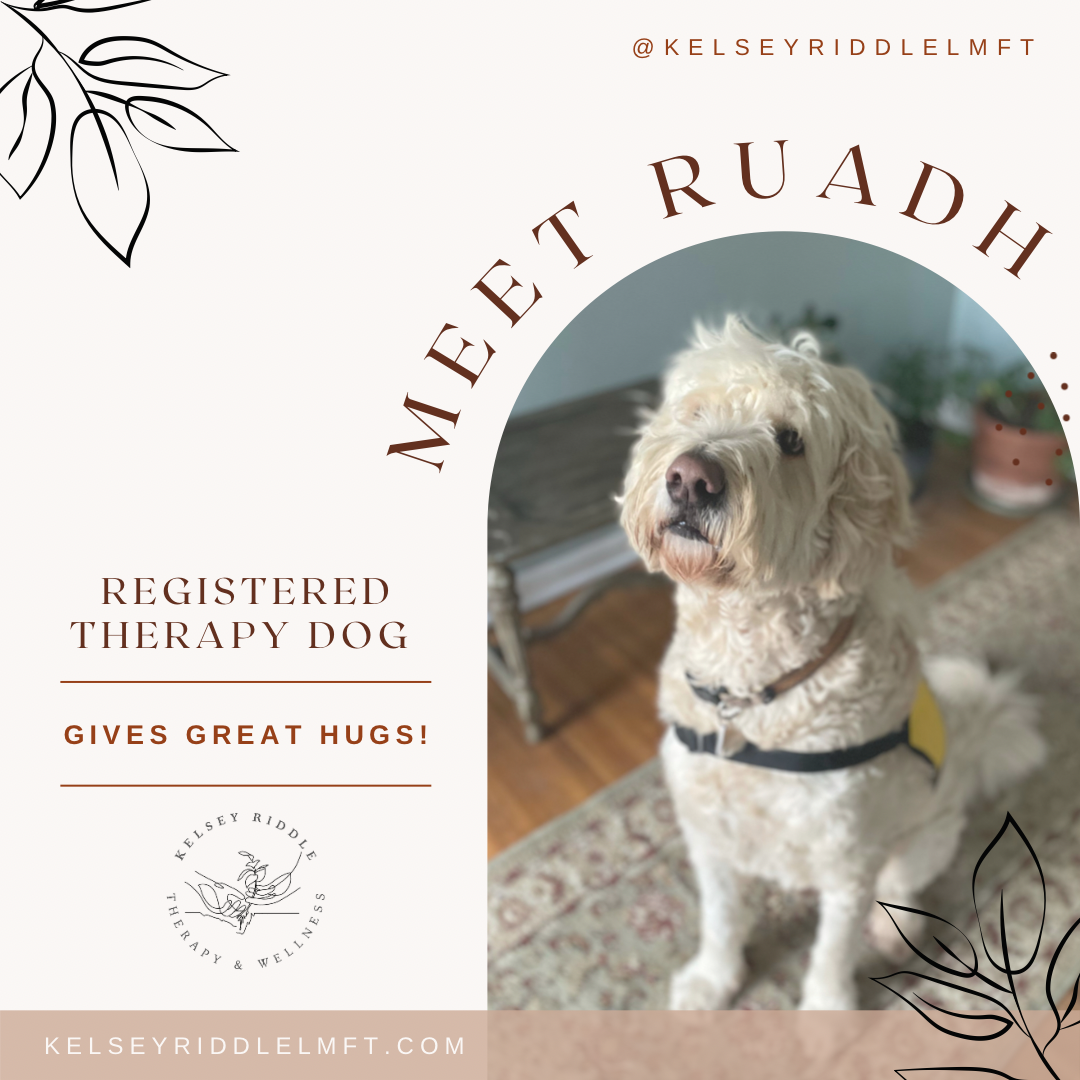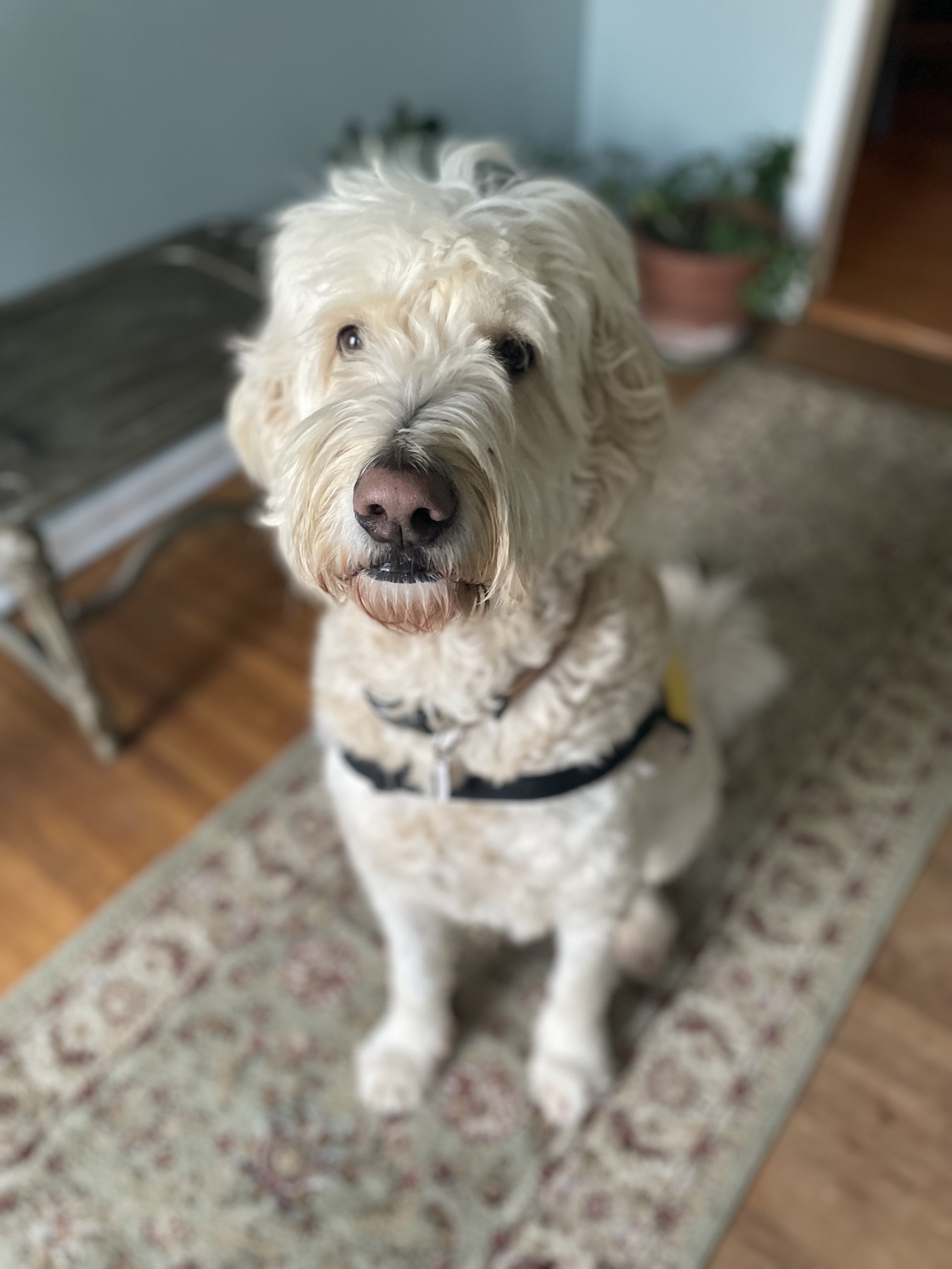Meet Ruadh! Kelsey Riddle Therapy & Wellness’ therapy dog. He is a 110 lb goldendoodle (we call him a megadoodle) who lives for scratches, swimming, and rolling in the grass. His name is gaelic and pronounced “Roy”. He is the sweetest being & his joy is contagious. He is gentle & extremely silly. He loves people and attention. People are always surprised at how big he is, and how docile. Everyone who meets him falls in love! He’s almost 8 years old but that didn’t stop him from learning new tricks to become a therapy dog this summer.
Kelsey & Ruadh are a registered therapy animal team with @petpartners, an awesome organization.
Steps to take if you've been struggling with your mental health
I’m really proud of a friend of mine who reached out about how she was feeling lately. I think a lot of people may relate, and wanted to pass my thoughts along
How To Get the Most Out of Couples Therapy
Read “Hold Me Tight” by Sue Johnson. This book is written for couples by the creator of Emotionally Focused Couples Therapy. It is a great intro that can introduce you to the concepts we use in our therapy, and can help you begin to gain insight about how you show up in your relationship cycle.
Don’t wait until the relationship is in crisis. Couples therapy can teach you many skills and create positive dynamics in the relationship that are best to apply early on.
Focus on yourself rather than your partner. We all have a part in the overall dynamic and the most helpful thing I see in the therapy process is when both partners are willing to look at their side.
Schedule consistently. We want to scaffold from each session into the next, and work to get momentum and change outside of the session. Couples will get the most out of the process if they schedule every week or two weeks at the most.
Let your therapist guide the process. Couples therapy is a process that starts by creating safety, trust, and understanding. This needs to go at an appropriate pace for the couple. Please trust your couples therapist to help guide you through the process.
Learn More:
Check out my full list of couples resources
Read my blog: Safety and Connection Part 1
Read my blog: How to Start a Conversation about Connection
Read my blog: Tips for a Great Marriage (On My Anniversary)
Read my blog: My Best Advice for Every Couple
Safety and Connection: Part 1
“Emotional safety enables us the freedom to collaborate, dream, be wildly creative, share bold ideas, feel increased compassion, and express ourselves freely with one another.” Ellen Boeder
My work as a therapist is informed by theories that make sense of how and why humans rely on connection to one another. We understand through John Bowlby’s Attachment Theory that humans are wired to bond: it’s imperative to our survival as children, and to our ability to thrive as adults. We’re also wired to protect ourselves from the devastation of disconnection.
Stephen Porges’ Polyvagal Theory helps us better understand how our nervous system relies on feelings in our body to assess our level of risk and safety around us, and takes these cues or triggers and responds accordingly. This is informed both by what’s happening now, and by what you’ve experienced in the past (trauma).
Your body is in constant and unconscious analysis about how and when you are safe to reach for connection.
When you are in emotional distress, you move into a different physiological state. We commonly call this things like ‘being flooded’, ‘being triggered’, being in ‘fight or flight mode’. Your heart rate increases, stress hormones like cortisol and adrenaline are released, and your brain function decreases in your prefrontal cortex (where your ‘executive functioning, i.e., the grounded and mature part of you that has perspective) and increases in your amygdala (the fear center — think fight or flight!). Your thinking gets more rigid and catastrophic, and narratives regarding your deepest fears are activated.
The bind is, in this state, “when we don’t feel safe, our bodies don’t want to engage, connect, or provide the emotional warmth our relationships need to thrive,” thus perpetuating the cycle of disconnect in relationship.
In relationships, this can show up in very subtle and nuanced ways. Many couples get stuck in cycles of disconnection that go like this: Partner A is critical, Partner B counter-attacks, Partner A becomes flooded and shuts down, Partner B feels abandoned. Neither partner feels emotionally safe or secure. Watch this video on Taming the Cycle for a great example about this underlying emotional meaning when couples get stuck in their cycles of conflict.
When you feel hurt or afraid, how do you in turn contribute to a sense of emotional unsafely in the relationship? Do you pull away, shut down, or get angry and attack back?
Can you notice the instinct to self-protect in those moments? Notice with compassion, that you are just doing your best to keep yourself safe right now. But what if you could do something different with that fear or hurt? What if you could bring that to the relationship to be cared for and responded to instead? The body needs the support of warm and safe cues around it to help it feel safe to open up.
We are so deeply wired to connect. But just as strong, our brain and body are constantly on the lookout for what they sense as unsafe or dangerous, emotionally. For people who have not experienced safe love, you have likely learned that connection and closeness are actually dangerous. Many people benefit from doing individual work around their childhood trauma and other relational experiences to help their body to give and receive vulnerability in safe relationships now. You may also benefit from working on these dynamics, and working to build emotional safety in your relationship through couples therapy.
What you can begin to do:
In the relationship: Consider what you need when you are feeling emotionally unsafe. What would help you to regulate at this moment, and to know that you are okay? It may be a reminder from your partner, and soft glance, or a hug. Could you ask your partner for that?
Process your part: Do your work on your traumas and experiences that have shaped your nervous system. Seek support in your healing, and in your ability to regulate your fear and hurt when it is activated in relationship. Physiological self-soothing allows us to show up with our whole-hearted self in the face of relational disconnection. From this place, we can better offer and receive the emotional safety that both partners are needing at that moment. (EMDR is a great method for doing this work in therapy).
Normalize the physiological response: Begin to identify and voice your body’s responses to emotional disconnection. Notice how you show up in the relationship from the protected stance, and perpetuate emotional unsafely in the relationship. Attend to safety and connection first. If this is difficult, agree to take a break, at least acknowledging the shift in body response that is blocking the connection.
Sources & for More information:
Read more about Emotional Safety is Necessary for Emotional Connection by Ellen Boeder
Polyvagal Exercises for Safety and Connection by Deb Dana
Learn More:
Read my blog: How to Start a Conversation about Connection
Read my blog: Tips for a Great Marriage (On My Anniversary)
Read my blog: My Best Advice for Every Couple
KRTW: Activism and Advocacy
“Therapy is political because therapy addresses the whole person and the systems they exist within” — @theempoweredtherapist
I believe it’s my role as a family therapist to take a position on important social justice movements and issues, as they affect family and community wellbeing. Family therapists who are trauma informed will be able to voice an evidence based viewpoint on important issues. I believe that all people, people of color, queer people, mothers, women of all orientations — and all marginalized folks — deserve to live lives of well-being, and our society plays an important role of fostering that. Our society has let these folks down for too long and continues to do so. As a therapist, I take an anti-oppressive stance. I condemn discrimination and am intolerant of hate and oppression.
I am radically accepting while being intolerant of discrimination and oppression.
I’m committed to consistent exploration, education, and pursuing perspective about my own experiences and privilege in the world, especially as a white cis woman and therapist. It’s important that as therapists, we don’t remain neutral toward, or worse enable, systems that oppress and traumatize the people we support. I do my best to keep this perspective in mind while guiding my work with my clients, while inviting them to explore their symptoms through the lens of systemic influence as well.
It’s important that as therapists, we don’t remain neutral regarding system that oppress and traumatize the people we support.
It is important to me to be a safe space. I believe true safety is more than acceptance: safety is love, respect, and celebrating the person in front of you for all they are. I am intentional about bringing safety to the virtual therapy “room” by inviting my clients to teach me who they are. I have an unconditional positive regard toward my clients, and help them to see their behaviors and symptoms through their own trauma and experience of the world. I am radically accepting while being intolerant of discrimination and oppression. Healing can be created by giving yourself compassion for how the world we live in has impacted you.
It is my intention to continue to do my own work as a person, as a member of my community, and as a good steward of the planet.




